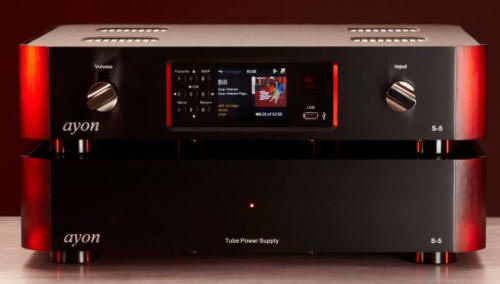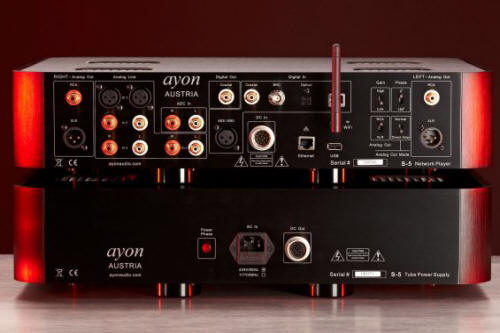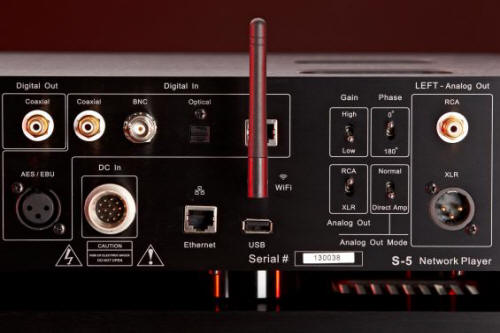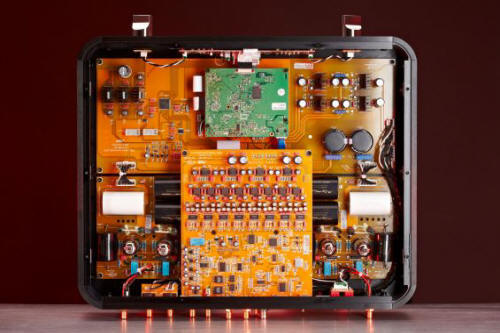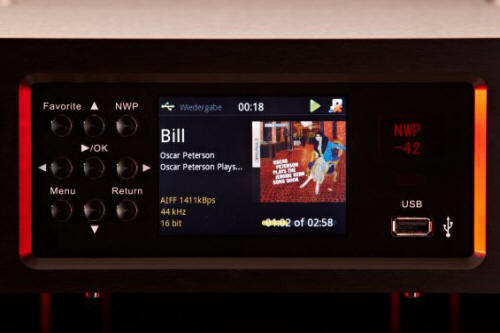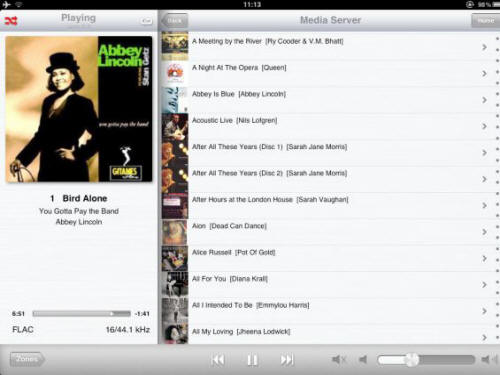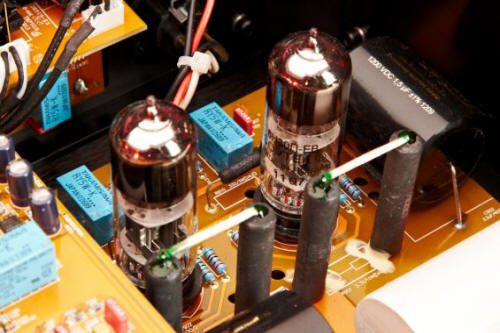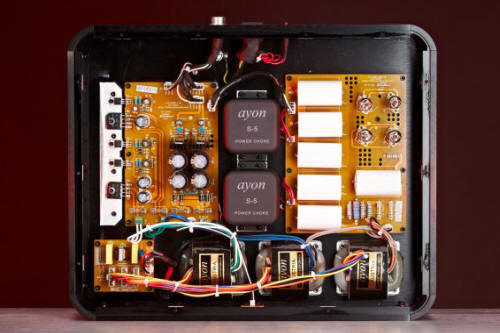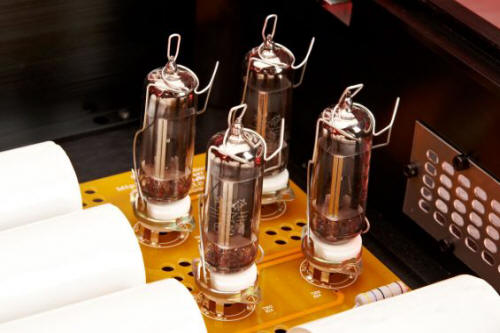|
|
You are reading the older HTML site
Positive Feedback ISSUE 67
ayon audio S-5 Network Server as reviewed by Dr. Jürgen Saile
[Dr. Saile's article appears courtesy of HiFi Statement; this publication in Positive Feedback Online is its first English translation. All images have been supplied by the author.] For a long time I have been awaiting the arrival of the Ayon Audio S-5—more precisely since the High End Munich in May 2012. There was an exhibition model at that show with an acrylic cover so that one could get a glimpse of the internal design. The first impression I had was that here Ayon pulled out all the stops and did it up big time. By mid-November of 2012, the time had come: HiFi Statement received this device for evaluation. In the editorial office there were two parcels ready for pick-up, as the S-5 consists of two components, unlike the smaller model S-3's single component design. The new model accommodates the power supply and the control unit in separate housings of equal size. As with all Ayon products, the housings are made of 12mm thick black-brushed aluminum. And the execution of this design gives an outstanding impression. The S-5 is designed as a universal device and combines preamplifier, streamer, and converter in one housing. There is no CD-drive due to space constraints in the housing. Other devices with line-outputs can be connected via analogue inputs; the S-5 also provides for connection with the internal converter with all current digital possibilities including I²S. The streamer can be operated in a wireless LAN mode (WIFI) as well as wired in a LAN via Ethernet. As with all their devices, Ayon attaches great importance to a stable power supply. Three powerful R-core transformers separately supply digital and analogue components. Furthermore, the power supply for the output tubes is designed as a choke power supply with capacitors and big coils alternating providing for the filtering. This elaborate kind of power supply delivers excellent results, but isn't used universally due to the obvious costs involved. The rectification for the analogue section is done by four 6Z4 double-rectifier tubes in Graetz bridge circuitry. With this variant circuitry a less pulsating voltage is achieved already behind the rectifier; the rest is flattened by film capacitors and a choke-filter. Additionally, the result is an improved current capacity at impulses, compared to only one rectifier tube in the circuitry.
Abundant connections—the S-5 also passes as full-fledged preamplifier The output stage is designed with tubes, of course, using the indirectly heated Russian 6H30EB dual triodes, as Ayon has gained relevant experience with this type. Originally the tube was manufactured for the Russian military; the EB-type applied here was more intended for industrial applications. Depending upon the implemented design, the tube has a life expectancy of up to 10,000 hours. The 6H30 has a μ of 15, i.e. a medium amplification, corresponding approximately to the ECC82. But compared to this tube, it can provide peak values of 2-3 A of current, an astonishing value for a miniature dual triode. I consider the medium amplifying factor an efficient solution, because too high of an amplification will have to be down-regulated elsewhere. Much more important here is a sufficiently spacious head-room, but this is a completely different subject. Both triode-halves are switched in a parallel single-ended variant, and hence mandatorily operate in class A. There is absolutely no negative feedback. For a better adaptation to other components of the music equipment, the output level can be reduced by means of a toggle-switch, which is gratefully accepted by an owner of a high efficiency speaker. To couple the tubes with the output Ayon uses Mundorf capacitors of the Supreme Silver-Gold type; the quality of the capacitors applied here plays a decisive role for the final result. Volume is controlled analogously with a resistor network, thus avoiding the problems of a digital control at low sound levels. A transformer-coupled control as in the big Spheris II preamplifier would have been exciting but would have exceeded the financial limits, and probably also the spatial ones.
Easily recognizable—the WIFI (wireless LAN) antenna for the wireless connection to the router Interestingly, Ayon relies on the proven Burr Brown 1704 DAC chip. This was produced from 1998, but hasn't been in production for some time. To be prepared for all eventualities Ayon's Gerhard Hirt has a "certain quantity" in stock. Meanwhile I know several manufacturers preferring the "old" R2R converters, i.e., TDA 1541, PCM 63 or even the BB 1704 to the modern sigma-delta converters for reasons of sound reproduction. In the R2R system there is a reference voltage applied to the resistor network, and the resistors serve as voltage dividers. In simple terms, the single bits control the resistors: "bit = 0" means that the resistor is grounded; "bit = 1" means that the resistor is connected to reference voltage. Hence every single bit contributes to the resulting output voltage. Therefore, evidently the resistors must be produced with ultimate precision; in the case of the BB 1704 they are laser-trimmed. Due to the high technical effort in production, the chips always were relatively expensive. Additionally, here there are four chips per channel connected in parallel, resulting in reduced noise and a higher output level, of course. The streaming unit comes from the Austrian specialist Stream Unlimited. Their expertise got around internationally, so that other renowned manufacturers also resort to their solutions. By the way, Stream Unlimited is composed of people who are formerly staff members of the Philips factory from the start-up period of the CD. If these boys don't have what it takes, who does...?
The compact and dainty design of the S-5
There are various possibilities for music listening with the S-5. The simplest would be to connect a small portable USB hard disk and go with it! However, note that a USB hard disk should be formatted FAT32, because the device does not accept all formatting, e.g., the one for the Mac OSX. This way fainthearted owners would be independent of the network and its viruses, but could not listen to internet radio, another feature of the S-5. Keep in mind the bitrate question for streaming audio via the Internet, however. Listening to a broadcast with 64 kbits-per-second transfer speed with a big installation is not the same as listening to highly interesting music productions like, for example, those from BR Klassik, ones that I would not want to miss. They are transmitted with at least 128 kbits per second. Of course, the most favorable connection is not USB: the S-5 loves to be connected with the network and to grab data from the NAS. For some readers the problems start right here. Not everybody is a network technician in disguise, or simply does not want to deal with networks only for music listening. I can understand this very well. On the other hand, setting up such a mini-network is not really difficult and is described well and easily understandable in the enclosed brochure that comes with the S-5. Besides a LAN connection the S-5, can also be operated with a wireless LAN (WIFI); this works without any problems, as long as the received signal is sufficiently strong. In this case, setting up the network only requires entering the security code of the router into the S-5.
Nice display of the cover and metadata; one could click through the archive with the keys, if there was not a better solution Now you can click through to the desired music with four selection keys and a small 3.5" display; professional zappers pick up the remote control. The display of the cover and the metadata on the mini-screen is very nicely done, but one should avoid this method, as Ayon offers a much better solution for selecting the albums. There is a free APP available for iPads, iPhones, and also for Android systems, of course. Via UPnP all metadata including cover are downloaded to the iPad, so that you can control the whole library from the couch. The surface design differs from the usual iTunes, as this is a proprietary development. High resolution formats up to 192kHz/24-bit PCM are reproduced without any problems. The S-5 automatically switches between the formats when they are played alternately. [Editor's note: the S-5 does not support DSD playback at this time, unfortunately.]
The interface is a proprietary development by Ayon. With the controller at the bottom the volume could be changed digitally, but the analogue operation with the remote control is preferable. I have listened with two variant sources: with a portable USB hard disk, and via a network consisting of Fritzbox, Western Digital NAS, and CAT 6 wiring. Interestingly, there really are tonal differences between these two types of connection. With the NAS it sounds more voluminous and organic at the same level of resolution with the same sources. I cannot judge to what extent the quality of the router or the CAT wire plays a role in these sonic results. Eventually, we listened to six routers by comparison. But I draw the line at comparative router listening! Back to the S-5: as with every tube device, the 6H30 should be granted a certain burn-in period. The manufacturer recommends 30 - 50 hours; certainly you should use nothing less than the lower limit. During this period, the sound picture changes continuously; you should be patient and not try to hectically adjust your tonality with any tuning. This burn-in period is not a peculiarity of the 6H30, but completely normal for all new tubes. Tube fans know this, of course. Towards the end of the burn-in period, the space opens widely, the resolution improves further, and again the bass is more controlled. The music appears more competent, more grown-up.
The Russian 6H30 tubes operate in the parallel-single-ended mode; for balanced output two tubes are needed, of course. First I selected Puccini's opera La Bohème recorded by Herbert von Karajan with Mirella Freni and Luciano Pavarotti in the leading parts. For Puccini, Karajan perhaps is not necessarily the very first you think of, but the interpretation is excellent, and the Berlin Philharmonic play as if they had Italian blood in their veins. Moreover the sound quality is excellent—as with almost all recordings of Decca's high period. Already, at the beginning of act three it shows that the output stage can easily drive the power amplifiers, and credibly brings the spectacular entrance of the orchestra into the living room. Moreover, the server outstandingly represents the stage in its spatial dimension. The movements of the singers and their individual positions among each other can easily be recognized. But here there is more to it; at that time I have heard this opera in Munich with Mirella Freni and have seen whole rows of spectators with their handkerchiefs. When this mood is not transported, and you can listen while reading the newspaper, there is something essentially wrong with the installation. Anyway, with other digital equipment I never experienced this recording as dramatically and emotionally as with the S-5. Scene change: Joe Newman at Count Basie's. The champion of the piano does not play along; this is a recording from Count Basie's jazz club in New York. Newman played in the Basie big band himself, and later tried to build a bridge between the fading swing era and the be-bop time. This recording captures the club atmosphere very well. You can listen to exactly how the musicians communicate and cheer each other onwards. The background noise of the audience in the lower levels gives you a feeling as if you are a part of it all. Of course, this is only ambient noise having nothing to do with the music, but in live-recordings this is just what rounds it off, especially when they are transmitted as naturally as being here. With the first title, "Caravan," it already gets right to the point. The band really rocks, and together with the background noise an incredibly sizzling live atmosphere is communicated. In your room you virtually can see the tom-toms vehemently played by Ed Shaughnessy on drums at the beginning, even if Shaughnessy seems to have arms two meters long. This is an old mistake at the early stereo days to demonstrate the advantages of stereo recordings.
A gigantic power supply, that would be well suitable for some power amplifiers Beethoven piano sonatas, interpreted by András Schiff: a grand piano always was an instrument difficult to reproduce. Older readers perhaps remember Schröder of the Peanuts with his children's piano. With some piano recordings these comics immediately come to my mind. The difficulties do not lie in the gamut of up to eight octaves—the deep bass strings of a grand piano reach a sub-contra A with a frequency of 27.5Hz, and in a Bösendorfer 290 even 16.4Hz – but also in the extreme dynamics which this instrument is capable of. Here Schiff plays a "lowered" Steinway Grand, modified by Angelo Fabbrini in Pescara, Italy. (Cars aren't the only things that are tuned!) Admittedly, the instruments of Fabbrini are perfected in a way that renowned pianists such as Pollini, Ashkenazy, Barenboim, or even András Schiff all prefer to play these instruments. Another reason is that the instruments of the different manufacturers have tended to produce a uniform sound, and the artists increasingly look for rather individual properties. And Fabbrini seems to be one of the best names out there for this. Fabbrini buys his pianos from Steinway in Hamburg, engineers the sound-decisive parts according to his own ideas, and replaces them in the piano. The result: a hot-rodded piano! The recording by ECM in the Zurich Tonhalle is excellent as always. With the S-5 one does not simply hear a piano between the loudspeakers, but you can imagine the size of the instrument very well. The impact of the stroked strings in the room is impressive, indeed. Otherwise the third movement of the Appassionata would lose much of its expressiveness, and would sound rather as background noise overall, rather than Beethoven, as it too often does. Another remark for fans of spatiality: with the S-5 there is a lot of air around the instruments; you can easily hear that the piano stands in the empty Tonhalle.
Rarely applied circuitry variant: four rectifier tubes in a bridge circuit. The output stage of the S-5 with its low output resistance of 700 ohms, and the current capability of the 6H30, are so powerful that power amplifiers can be connected directly and without an additional preamplifier, and also with longer cables. This spares additional electronics in the signal path. However, in other cases this direct-connect variant never really convinced me. With an active preamplifier in the path, it always sounded more harmonious, somehow more convincing. With the S-5 it is different. Connected directly to the power amp, the result is an organic natural sound picture. One does no longer deal with details like dynamics, bass control, or resolution, but the whole thing appears simply perfect. The mentioned criteria abound, but remain an integral part of the music, instead of always calling the listener's attention. This becomes spectacular in large-scale orchestral works, such as Richard Wagner's Ring, Götterdämmerung, with Sir Georg Solti. Most audio installations are not able to deal with the crescendo-sections of the "Funeral March" of this old Decca war horse. Consequently you rather tend to turn the volume down, or even switch off. With the S-5, the entries of the orchestra come smoothly, and the huge dynamics are relaxed. Here also the dynamic capabilities of the WVL A100i loudspeaker play a crucial role. The tonality of the S-5 lies more on the neutral side, but has absolutely nothing to do with a prosaic impassive reproduction. Whoever thinks of tubes as a pleasantly soft and cozy reproduction, will be catapulted out of his sleep at the first impulse of a bass drum. The old saying, "For bad recordings God created the tube" becomes obsolete. Here nothing is leveled off or truncated; the S-5 does not leave us in the dark about the recording quality of the different CDs. But it does makes us listen to them. In addition the difficult reproduction of a violin comes through with astonishing reproduction. The basic prerequisite here are perfectly ripped CDs; encoded via iTunes you waste half. You can find out more in the test of the RipNas . As in all installations, the preamplifier is critical for the sound characteristics. Ayon rigorously lifted the output stage of the S-5 to a level, where you can skip an external preamplifier. Or, if one has won in the lottery, has an oil sheik as patron, or is a sheik oneself, you'll be able to afford the absolute top-preamplifiers of the company. Do I really have to find a fly in the ointment with this level of performance in the S-5? Well, there is a click in the speakers when switching the input sources, probably stemming from the relays. With a highly sensitive horn speaker this is more annoying than with a speaker of 86dB core audio pressure. Upon asking Ayon about this, I learned that a correction to this problem would lead to a deterioration of sound, and so they have left it as-is. Statement So far I found reproduction from the computer hard disk via USB connections tiresome after a while with the S-5. Therefore I always preferred my CD drive for music listening. With the S-5 the sometimes artificial appearance of the computer reproduction disappeared. The S-5 delivers an organic, powerful, and high-resolution reproduction and also communicates musical contents. This is tube technology at its best! Dr. Jürgen Saile PS: If you would like to see enlarged pictures of the S-5, please have a look at http://www.hifistatement.net/de/tests/item/1094-ayon-s-5 Read the Interview with Gerhard Hirt of Ayon Audio
Ayon S-5
Ayon Audio
Ayon Audio USA |








